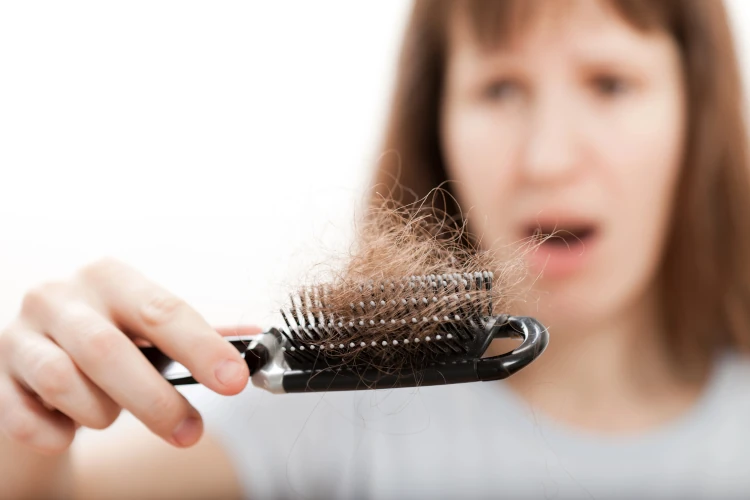
Does Hormone Replacement Therapy Cause Hair Loss?
Hormone replacement therapy (HRT) is a common approach to easing menopause symptoms like hot flashes, night sweats, and mood swings. Many women feel more balanced and comfortable during this stage of life when hormone levels are brought back into a healthier range.
That said, some women notice increased shedding or shifts in texture after starting HRT, often related to initial hormone fluctuations rather than HRT itself being inherently damaging to hair. Understanding how hormones influence hair can make these changes easier to manage.
- Understanding Hormones and Hair Loss
- How Hormone Replacement Therapy Can Influence Hair Health
- Factors That Can Increase the Risk of Hair Loss on HRT
- Managing Hair Loss While on Hormone Replacement Therapy
- When To Consider Hair Restoration After HRT-Related Hair Loss?
- Tips To Support Hair Health During Hormone Replacement Therapy
Understanding Hormones and Hair Loss
Hormones have a strong influence on how hair grows and sheds. Estrogen and progesterone generally promote hair growth, while testosterone — particularly its byproduct dihydrotestosterone (DHT) — can be linked to thinning in people with a genetic predisposition.
Estrogen helps keep hair in the growth phase longer, which leads to fuller, thicker strands. When estrogen levels decline during menopause, hair more easily transitions to the shedding phase. That often brings noticeable shifts in volume and texture.
Even low-normal testosterone levels may promote hair thinning in genetically sensitive individuals due to increased local DHT activity. Women who are more sensitive to DHT might notice thinning around the hairline or crown during hormonal fluctuations.
How Hormone Replacement Therapy Can Influence Hair Health
The effects on hair can depend on the HRT formulation. For example, bioidentical estradiol may have different effects compared to synthetic progestins, which in some cases may worsen androgenic symptoms.
Hormone levels need time to stabilize after starting or adjusting HRT. While your body recalibrates during treatment, it’s common to notice shedding or changes in how your hair feels.
These conditions tend to be temporary. Disruptions in estrogen or progesterone can throw off the hair cycle, causing more strands to enter the resting phase at the same time. Once hormone levels even out, the cycle usually resets. Many women start to see regrowth within a few months as their systems settle into the new hormonal pattern.
Some women even find that their hair becomes stronger or thicker over time, especially when HRT is correcting an imbalance that has been affecting growth for years. In these cases, consistency makes a meaningful difference.
Factors That Can Increase the Risk of Hair Loss on HRT
HRT may influence hair, but it’s rarely the only factor involved. Hair thinning often comes from a mix of causes that overlap.
Here are a few possibilities worth considering:
- Genetics: If you have a family history of hair thinning, your follicles may be more reactive to hormonal shifts. That sensitivity makes shedding more likely during changes like menopause or HRT.
- Pre-existing hair thinning: Hair that was already thinning before HRT may become more noticeably sparse during treatment. This isn’t necessarily a new issue — HRT might just make it more visible.
- Iron deficiency: Without enough iron, the body can’t deliver oxygen effectively to the scalp. That weakens follicles and accelerates shedding. Iron needs can also shift during menopause, increasing the risk of hair loss.
- Stress and poor sleep: High cortisol from ongoing stress interferes with hormone regulation. Sleep loss compounds the problem, leaving your body with fewer resources to repair and rebalance.
These influences don’t automatically result in hair loss. Pinpointing what’s happening in your specific case is what leads to better outcomes.
Managing Hair Loss While on Hormone Replacement Therapy

Noticing hair thinning during HRT doesn’t mean you’re stuck with it. Your doctor can review your dosage and hormone type to see whether a shift might help. Even slight changes sometimes ease unwanted side effects.
Examine your diet, too. Nutrients like iron, vitamin D, zinc, and biotin all support hair structure and growth and can be obtained through common foods. If bloodwork shows you’re lacking in an essential nutrient, supplements might also be worth exploring with your provider.
Additionally, don’t overlook your hair care habits when managing hair shedding or loss. Heat styling, frequent coloring, or harsh shampoos can all lead to thinning hair in women. Using gentler products and reducing friction or breakage can give your hair a better chance at recovery.
When To Consider Hair Restoration After HRT-Related Hair Loss?
Hair restoration may be considered if hair thinning persists after hormonal levels have stabilized and other causes like telogen effluvium or nutritional deficiency have been ruled out.
For those with persistent thinning or visible patches, a transplant can offer a more lasting and noticeable result. Regrowing hair is only part of the benefit; many people also feel a renewed sense of confidence and personal comfort as their appearance begins to match how they feel inside.
Hair transplants can be especially helpful for people who want a long-term, visible improvement after other methods have fallen short. They’re designed to work with your natural hair pattern and offer personalized results based on your specific type and extent of hair loss.
Seeing real examples can help set expectations. Before-and-after photos often highlight restored volume and confidence, and they offer a clearer sense of what’s achievable.
As with any treatment, weighing the hair restoration cost matters. Expenses vary depending on what you need and where you go. A consultation helps you understand the price breakdown and available options.
Tips To Support Hair Health During Hormone Replacement Therapy
Strong hair starts with your overall health. Eating a balanced diet with leafy greens, protein, and healthy fats can help keep your hair nourished. Staying on top of your nutrient intake plays a direct role in maintaining healthy follicles.
Managing stress helps, too. Practices like journaling, stretching, or quiet time with friends can take the edge off and give your hormones room to stabilize.
And good sleep can’t be overstated. Getting seven to nine hours each night gives your body the reset it needs to support everything from energy to hair growth.


